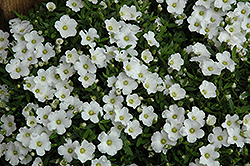Alpine Baby's Breath
Gypsophila cerastioides
Plant Height: 6 inches
Flower Height: 8 inches
Spread: 12 inches
Sunlight:
![]()
Hardiness Zone: 4a
Description:
A low growing variety that is well suited for rock gardens, rock walls, or alpine troughs; a compact mound of rounded green leaves; taller branches are studded with white flowers that may have pink veins; evergreen in milder areas
Ornamental Features
Alpine Baby's Breath has masses of beautiful white cup-shaped flowers with chartreuse eyes and pink veins at the ends of the stems from late spring to mid summer, which are most effective when planted in groupings. The flowers are excellent for cutting. Its oval leaves remain dark green in color throughout the season.
Landscape Attributes
Alpine Baby's Breath is a dense herbaceous perennial with a mounded form. It brings an extremely fine and delicate texture to the garden composition and should be used to full effect.
This plant will require occasional maintenance and upkeep, and is best cleaned up in early spring before it resumes active growth for the season. It has no significant negative characteristics.
Alpine Baby's Breath is recommended for the following landscape applications;
- Mass Planting
- Border Edging
- General Garden Use
- Naturalizing And Woodland Gardens
Planting & Growing
Alpine Baby's Breath will grow to be only 6 inches tall at maturity extending to 8 inches tall with the flowers, with a spread of 12 inches. Its foliage tends to remain low and dense right to the ground. It grows at a fast rate, and under ideal conditions can be expected to live for approximately 10 years. As an herbaceous perennial, this plant will usually die back to the crown each winter, and will regrow from the base each spring. Be careful not to disturb the crown in late winter when it may not be readily seen!
This plant should only be grown in full sunlight. It prefers dry to average moisture levels with very well-drained soil, and will often die in standing water. It is considered to be drought-tolerant, and thus makes an ideal choice for a low-water garden or xeriscape application. It is not particular as to soil type or pH. It is highly tolerant of urban pollution and will even thrive in inner city environments. This species is not originally from North America.

